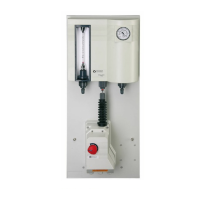2. Safety V10k automatic
6
EN
Waste disposal
Ensure safe and environmentally-friendly dis-
posal of agents and replaced parts.
2.3 Safety instructions specific to
the V10k system
• This unit may only be installed and servi-
ced by qualified personnel who are fami-
liar with the contents of the operating
instructions, works directives and regula-
tions for handling chlorine.
• The operators of the gas feed system must
be instructed in safe use of the unit.
• All personnel coming in contact with the
unit must be in full knowledge of the site
operation and emergency procedures and
also regulations for accident prevention.
• The gas control unit V10k must be con-
nected to a vacuum gas supply only, never
connect to a pressurized gas line.
• The discharge of chlorine gas from chlo-
rine containers should not exceed one
percent of the nominal container con-
tents per hour, as otherwise there is the
risk that the chlorine container and the
vacuum control valve become iced. There-
fore ensure that a sufficient number of
chlorine containers are connected and
open at the same time.
• When changing the gas cylinders always
wear a suitable and functional gas mask.
Practice use of the mask regularly. If chlo-
rine gas is discharged, only use a breat-
hing system which is independent of
ambient air!
• Do not tolerate any leakages in the chlo-
rine system. Leakage points must be sea-
led immediately as they will become
larger with time if they remain unatten-
ded. When inspecting the system for lea-
kage always keep your gas mask to hand.
• All connections and system components
must be carefully inspected for leaks
during commissioning, when chlorine
pipes have been released and re-connec-
ted and also regularly during routine daily
inspection, and any leaks must be sealed
correctly. If there are any traces of chlo-
rine in the air the cause must be determi-
ned and remedied immediately.
• When locating leaks with ammonia, never
pour, spray or drip liquid ammonia over
metal components (corrosion).
• One of the most common causes for leaks
on chlorine pipes are seals which have
been used more than once. For this rea-
son never re-use seals which have been
removed from the system, but dispose of
these immediately (also when changing
the gas cylinders!). Ensure that a suffi-
cient supply of new seals of the right size
and correct material is always available
(refer to overhaul kits or spare parts).
• Gaskets must always be stored in a dry
place! Damp seals lose their stability per-
manently, increase the danger of corro-
sion and should never be re-used!
• If a gas pipe is interrupted or opened,
close the openings immediately with a
rubber plug or similar material to prevent
the ingress of moisture. Moisture must be
kept away from all parts of the system
which only come in contact with dry chlo-
rine during operation. Dry chlorine is not
corrosive below 100°C. However, chlorine
in combination with moisture is extremely
corrosive and corrodes most metals such
as bronze or steel.
• Before servicing the system the gas supply
must be closed off directly on the gas
cylinders or tank and the chlorine gas in
the system must be consumed completely
(exception: leakage location or calibrat-
ion)
• Only use original Evoqua spare parts.
Employment of non-specified parts can
cause faults which can have dangerous
consequences. Evoqua does not accept
WARNING
Danger due to chlorine gas/sulphur dioxide!
Chlorine gas or sulphur dioxide gas irritates
the respiratory tracts. Contact with chlorine
or sulphur dioxide gas in high concentrations
irritates and damages the membranes, respi-
ratory system and the skin. In extreme cases
death can result due to suffocation.
NOTICE
In this manual the use of the V10k system
with chorine gas is described. The safety ins-
tructions for chlorine are similar to those for
sulphur dioxide. When sulphur dioxide is
used refer to the safety informations of the
gas supplier (e.g. the safety data sheet).

